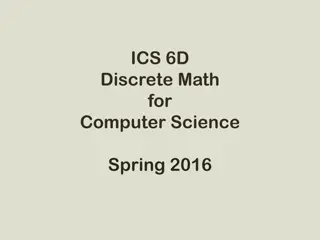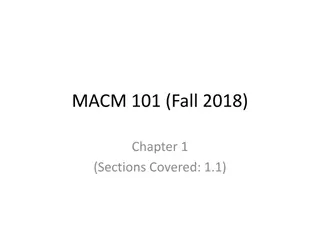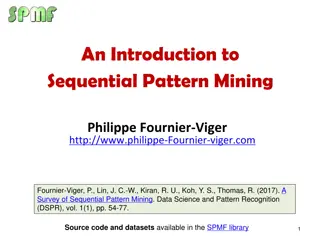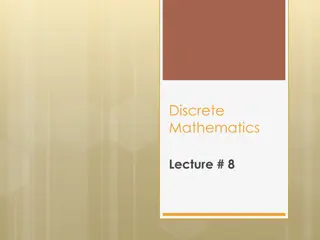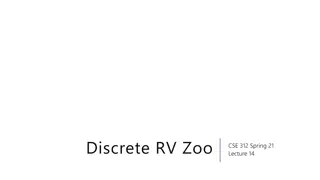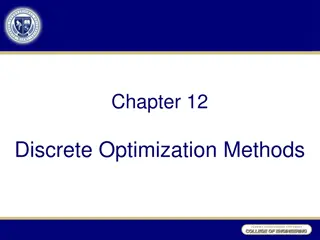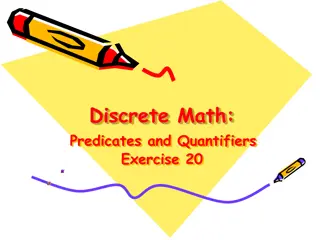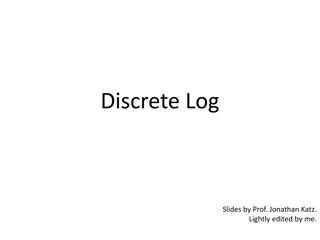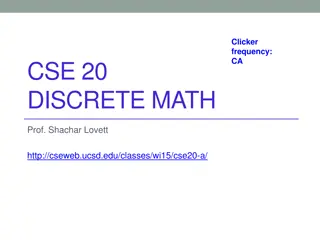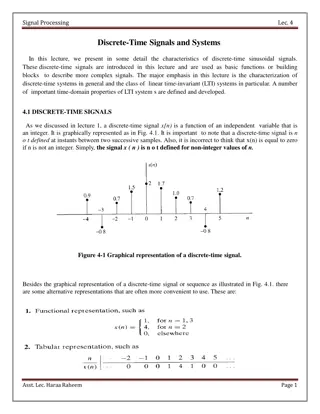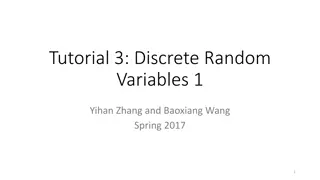Discrete Math for Computer Science Course - ICS 6D, Spring 2016
Prof. Sandy Irani leads the ICS 6D Discrete Math for Computer Science course at UC Irvine. The course covers various topics in discrete mathematics, with lectures on Mondays, Wednesdays, and Fridays. Teaching assistants and readers support the course, which includes interactive activities on zyBook.
9 views • 32 slides
Advancements in Discrete Auto Analyzers for Clinical Chemistry Operations
Discrete auto analyzers integrate specimen handling, reagent systems, optical components, and computers for streamlined functionality. The innovation in computer technology, particularly microprocessors, has revolutionized these analyzers, enabling precise data management, liquid handling, and optic
5 views • 17 slides
Microeconometric Modeling with Multinomial Logit Model
The topic discusses the Multinomial Logit Model in the context of discrete choice modeling, covering concepts, models, consumer preferences, utility maximization, and implications for discrete choice models. It explores how consumers maximize utility under budget constraints, the need for well-defin
3 views • 58 slides
Discrete Optimization in Mathematical Modeling
Discrete Optimization is a field of applied mathematics that uses techniques from combinatorics, graph theory, linear programming, and algorithms to solve optimization problems over discrete structures. This involves creating mathematical models, defining objective functions, decision variables, and
4 views • 12 slides
Discrete Probability Distributions
Explore the definition of random variables, probability distributions, and three types of discrete distributions - Binomial, Hypergeometric, and Poisson. Learn about the mean, variance, and standard deviation of probability distributions, as well as the difference between discrete and continuous dis
8 views • 32 slides
Discrete Mathematics through Graph Theory
Delve into the world of discrete mathematics with a focus on graph theory. Learn about graphs, their properties, and essential theorems. Discover how graphs model relations in various applications like network routing, GPS guidance, and chemical reaction simulations. Explore graph terminology, theor
0 views • 26 slides
Combinatorics in Discrete Mathematics
Combinatorics, a key facet of discrete mathematics, explores the arrangement of objects and finds applications in various fields like discrete probability and algorithm analysis. The Rule of Sum, a fundamental principle, dictates how tasks can be accomplished when they cannot be done simultaneously.
5 views • 70 slides
Arithmetic Mean Calculation Methods
Arithmetic mean can be calculated in individual, discrete, and continuous series. In individual series, each item is listed separately, while in discrete and continuous series, items are grouped with frequencies. The mean can be computed using formulas tailored to each type of series, including meth
0 views • 4 slides
Introduction to Sequential Pattern Mining Overview
Discover the concept of sequential pattern mining, a popular data mining task introduced in 1994, with a focus on analyzing discrete sequences to find interesting patterns. Sequential pattern mining involves finding frequent subsequences in sets of discrete sequences, such as items purchased by cust
1 views • 24 slides
Valid and Invalid Arguments in Discrete Mathematics
Concepts of valid and invalid arguments in discrete mathematics are explored through examples. Learn how to determine the validity of arguments based on premises and conclusions. Practice using truth tables to evaluate argument forms. Enhance your logical reasoning skills in Discrete Mathematics.
4 views • 22 slides
Discrete Scenarios in Graphs
The scenarios where the height of a student depending on age, time taken in a race depending on distance, number of students taking a test depending on class size, and length of a walkway depending on number of bricks are analyzed to determine which would result in a discrete graph with isolated poi
1 views • 23 slides
Discrete Random Variables and Variance Relationships
Explore the concepts of independence in random variables, shifting variances, and facts about variance in the context of discrete random variables. Learn about key relationships such as Var(X + Y) = Var(X) + Var(Y) and discover common patterns in the Discrete Random Variable Zoo. Embrace the goal of
2 views • 27 slides
A Zoo of Discrete Random Variables
Discrete random variables play a crucial role in probability theory and statistics. This content explores three key types: Bernoulli random variable, binomial random variable, and error-correcting codes. From understanding the basics of Bernoulli trials to exploring the application of error correcti
1 views • 27 slides
Discrete Optimization Methods Overview
Discrete optimization methods, such as total enumeration and constraint relaxations, are valuable techniques for solving problems with discrete decision variables. Total enumeration involves exhaustively trying all possibilities to find optimal solutions, while constraint relaxations offer a more tr
0 views • 80 slides
Predicates and Quantifiers Exercise Solutions in Discrete Mathematics
Exercise solutions involving predicates and quantifiers related to printer status, job status, and queueing in a discrete mathematical context. The solutions address scenarios like lost jobs, busy printers, queued jobs, and out-of-service printers. References to textbooks in discrete mathematics are
1 views • 4 slides
Cyclic Groups and Discrete Logarithms
Exploring the concepts of cyclic groups and discrete logarithms in group theory. This presentation covers the definition of generators, examples of cyclic groups, important theorems related to prime orders and cyclic groups, uniform sampling in cyclic groups, and the discrete logarithm problem. Exam
3 views • 14 slides
Functions in Discrete Mathematics
Functions play a fundamental role in Discrete Mathematics, defining mappings between sets and capturing relationships between elements. Learn about functions, their properties such as being one-to-one or onto, and how to determine if a given mapping qualifies as a function. Explore concepts like one
4 views • 23 slides
Discrete Event (time) Simulation
The process of designing a model of a real system to understand behavior or evaluate strategies. Types of simulation include static vs. dynamic, deterministic vs. stochastic, and discrete vs. continuous models. Understanding these basics is crucial for implementing a successful discrete event simula
0 views • 33 slides
Peer Instruction in Discrete Mathematics
Topics on relations and equivalence relations in discrete mathematics through engaging peer instruction sessions. Understand the concepts of symmetry, reflexivity, and transitivity in relation graphs with interactive visuals and theorems. Dive into the fundamentals of discrete mathematics with Dr. C
3 views • 20 slides
Introduction to Discrete Mathematics Course
Discrete Mathematics MACM 101 taught by Binay Bhattacharya covers important themes, goals, and syllabus information. The course includes lectures on Mondays, Wednesdays, and Fridays with additional office hours available for students. Topics like Continuous vs. Discrete Mathematics are explored, emp
2 views • 26 slides
Introduction to Discrete Mathematics
Dive into the essentials of discrete mathematics with a focus on GCD calculations, checkerboard configurations, and problem-solving techniques. Explore course materials, requirements, and practical examples. Join this engaging journey to strengthen your foundational knowledge in discrete mathematics
5 views • 54 slides
Discrete Math: Logic Exercise 3
In this exercise, practice your logical reasoning skills with problems on discrete mathematics. Strengthen your understanding of logical operators, truth tables, and propositional logic. Enhance your problem-solving abilities by tackling various scenarios and applying logical rules effectively. Get
2 views • 4 slides
A Discrete Approach to Continuous Logistic Growth
This article delves into the concepts of continuous and discrete logistic growth models, exploring linear growth factors, inverse linear growth factors, and methods for solving applied problems. The content covers symmetry in inflection points, fitting data using least squares, and pros and cons of
1 views • 22 slides
Sets and Functions
This course covers essential topics in discrete structures, sets, and functions for Fall 2018. Students will explore foundational concepts and theories in discrete mathematics to build a strong understanding of sets, functions, and their applications in various fields. The course emphasizes problem-
4 views • 44 slides
Discrete Structures Overview with Logic Foundations
In this chapter, you will delve into the fundamentals of discrete structures, including propositional logic and logical operators. Explore examples of propositions and popular boolean operators like negation, conjunction, and implication. Gain insights into the foundations of logic, exploring compou
25 views • 41 slides
Foundations of Discrete Optimization
Delve into the fundamentals of discrete optimization through an exploration of random access machines, decision problems, and polynomial-time algorithms. Uncover the essence of P, NP, and NP-Complete problems, as outlined in the realm of discrete optimization. Dive deep into the workings of a Random
3 views • 77 slides
Discrete Structural Analysis in Comparative Economic Organization
This study by Oliver E. Williamson in 1991 delves into the analysis of discrete structural alternatives in economic organization. It compares the distinct forms of economic organization - market, hybrid, and hierarchy - focusing on coordinating mechanisms, adaptability to disturbances, and contractu
4 views • 15 slides
Discrete Deconvolution in DSP Systems
Explore the concept of discrete deconvolution in Digital Signal Processing (DSP) systems, learn how to determine FIR or IIR system types, implement deconvolution using z-transform, and analyze the spectral properties of discrete signals through Fourier series. Gain insights into finding h(n) given x
2 views • 14 slides
Discrete Mathematics and Its Importance
Discrete mathematics involves studying mathematical structures that are distinct and separate rather than continuous. It is essential for various fields such as computer science, cryptography, and digital electronics. This article explores the basics of discrete math, its applications in real-world
2 views • 14 slides
Discrete Optimization in Graph Theory
Explore the relationship between counting techniques, graph theory, and discrete optimization, with examples illustrating the transition from counting problems to optimization problems. Learn about applying optimization in scheduling and making graph models, as well as the role of graphs in discrete
3 views • 8 slides
Discrete-Time Signals and Systems: Characteristics and Properties Explained
Explore the characteristics of discrete-time sinusoidal signals and the general properties of discrete-time systems, focusing on linear time-invariant systems. Learn about impulse responses, convolution sums, and key properties of convolution operators in signal processing.
2 views • 16 slides
Discrete Random Variables and Associated Probability Functions
Explore the concept of discrete random variables, their associated probability mass functions, and examples of typical discrete random variables like the Binomial and Poisson random variables. Understand the difference between discrete and continuous random variables with practical examples.
2 views • 19 slides
Introduction to Discrete Structures Spring 2020
Teaching assistants, roles, office hours, online information, course outline, and important dates for CSCE 235H - Introduction to Discrete Structures in Spring 2020 at the University of Nebraska-Lincoln. Learn about the course structure, instructors, grading policies, online resources, and key dates
3 views • 55 slides
Group Choices for Discrete Log Assumption
Explore the concept of group choices for the discrete logarithm assumption in cyclic groups, prime-order groups, and prime-order subgroups. Learn why certain groups are believed to make the discrete logarithm problem hard and how to select optimal groups for cryptographic applications.
1 views • 10 slides
Discrete Probability Distributions
A random variable is a numerical description of an outcome in an experiment, where it can be discrete or continuous. Examples and illustrations of discrete random variables with finite or infinite values are provided. Explore how probability distributions describe the likelihood of different outcome
3 views • 60 slides
Discrete Random Variables and Their Analysis
Learn how to analyze discrete random variables in statistics, including creating histograms, calculating mean and standard deviation, and interpreting probability distributions. Explore the concept of Apgar scores for newborns and how to calculate the expected value of a random variable. Discover th
0 views • 7 slides
Introduction to Discrete Mathematics: MACM 101 Overview
Discrete Mathematics course MACM 101 with Lecturer Binay Bhattacharya covers topics such as continuous vs. discrete math, course information, grading criteria, and more. The course emphasizes mathematical techniques for discrete math and its relevance in computer science. With insights into lectures
1 views • 25 slides
Understanding Discrete Probability Distributions for Statistical Analysis
Explore the concept of discrete probability distributions in statistics, focusing on variables with numerical values arising from counting processes. Learn about probability distributions, expected values, variance, and standard deviation of discrete variables through practical examples.
5 views • 28 slides
Understanding Discrete Random Variables and Probability Distributions
Learn about two types of random variables - discrete and continuous, and understand how to calculate probabilities with a focus on discrete random variables. Explore the concept of probability distributions and their applications in statistics and probability to analyze outcomes of chance processes.
2 views • 9 slides
Discrete Mathematics for Computer Science: Overview and Course Details
Explore the course "Discrete Mathematics for Computer Science" instructed by Dr. Abdelouahid Derhab. This introductory course covers foundational topics such as sets, sequences, logic, relations, counting, graphs, and trees. Students will develop problem-solving skills and discover how discrete math
1 views • 8 slides
